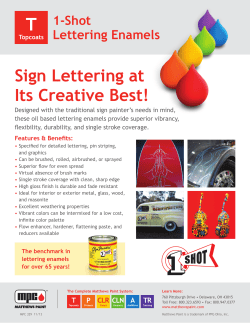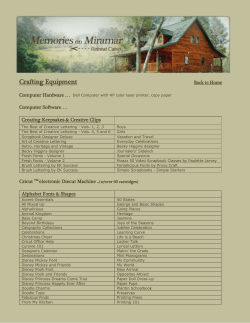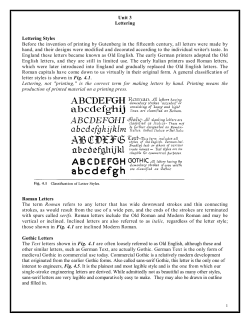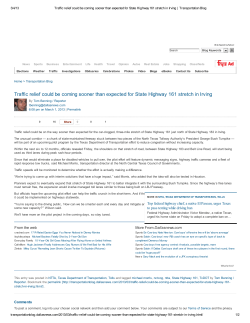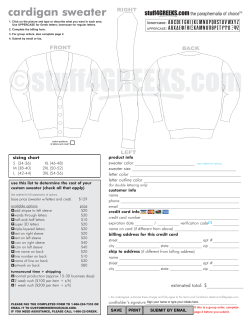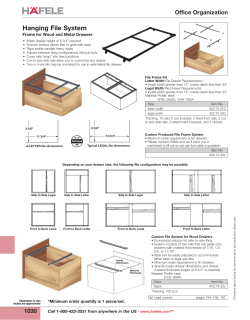
Document 28787
SIGN There are general guidelines to follow in the design of highway signs in order to conform to basic standards. Many of these pointers are mentioned in various sections of the Manual on Uniform Traffic Control Devices (MUTCD) while others are derived from accepted practice in sign design and layout. Highway signs with standardized designs conforming to the general guidelines (Iike most regulatory, warning, civil defense, school, railroad-highway grade crossing, and bicycle signs), are contained in this booklet and may be shown with different fixed standard sizes depending on the types of highway or facility where the sign is intended to be used. Although some guide signs also have been standardized and are included in this booklet, most guide signs need to be designed separately because of the variability in message or legend. For most guide signs, there can be no rigid standardized sizes. Sign DimeneIoa Message variability controls the overall sign dimensions and, whenever practicable, the overall dimensions of the sign plates should be in multiples of 6 inches. The use of a smaller than “standard” size sign may sometimes be justified. For instance, a sign mounted over a particular roadway lane to which it applies may have to be limited in width to the lane width. In some cases, vertical clearances may limit the vertical dimension of the sign. On the other hand, a larger than “standard” size sign may be desirable where greater legibility or emphasis is needed. When a variation in the “standard” size is necessary, a reduced or enlarged (as the case may be) letter height, interline, and edge spacing may be used but should be as nearly comparable to standards as possible. Type of letters used shah be those shown in either the I!466 edition or the 1977 Metric Edition of the Standard Alphabets for Highway Signs booklet. As a guide to choice of alphabets, tests have shown that, for any given legend, better legibility can be obtained by using a relatively wide spacing between letters than by using wider and taller letters with a cramped space. Sign lettering shah be in uppercase letters except that destination names may be in lowercase lettering, with initial uppercase. The initial uppercase letters used in conjunction with lowercase letters wiU be Series E(M) and shall be approximately 1 i/j times the “loop” height of the lowercase letters. Use of the Series B alphabet is restricted to street name signs, parking signs, and other similar signs where limited breadth and stroke widths are required for design purposes. ‘REPRINTED FROM STANDARD HIGHWAY SIGNS AND STANDARD ALPHABETS FOR HIGHWAY SIGNS COURTESY OF THE FEDERAL HIGHWAY ADMINISTRATION B-l -GUIDE SIGN DESIGN Sixe of Lettering For guide signs on expressways and freeways, the prescribed numeral and letter sizes, according to interchange classification and component of sign legend, appear in Tables II-l and II-2 of the MUTCD. The minimum sizes specified should be exceeded where conditions indicate a need for greater legibility. For conventional roads in rural districts on major routes, the principal legend on guide signs shall be in letters at least 6 inches in height. On less important rural roads and on urban streets, the principal legend shall be in letters at least 4 inches high. Lettering on street name signs should be at least 4 inches high. Supplementary lettering to indicate the type of street or section of city may be in smaller lettering but at least 2 inches high. An accepted “rule-of-thumb” to follow for legibility for signs other than Interstate is to have 1 inch of letter height for every 50 feet of desired legibility. Amount of Legend The MUTCD states that regardless of letter size, the legend on a guide sign must be kept to a minimum to be instantly legible. For example, on expressways, the legend on a guide sign should only have two destinations and the directional copy. Directional copy, not exceeding three lines, may include symbols, route numbers, arrows, cardinal directions, interchange number(s), and other exit instructions. Conventional road guide signs should be limited to three lines of principal legend which includes place names, route numbers, and street names. Arrows In the Appendix, two sets of arrows are illustrated for use in highway signs. With few exceptions, which include guide signs, the “standard arrow” is for all types of signs. The “Up” and “Down” arrows are to be used for guide signs and recommended applications are stated in Section ZD-8 of the MUTCD. Borden With few exceptions, the MUTCD requires all signs to have a border of the same color as the B-2 legend. A dark border should be set in from the edge, while a white border should extend to the edge of the panel. A suitable border for 3CGnch signs with a light background is from one-half to three-quarters of an inch in width, one-half inch from the edge. For similar signs with a white border, a width of an inch is appropriate. For other signs, the border widths should be of similar proportions but should not exceed the stroke width of the major lettering of the sign. For guide signs, smaller than 6 feet by 10 feet, a width of approximately 1% inch may be used; for those exceeding 6 feet by 10 feet, the border should be about 2 inches wide; and for unusually large signs, a border 3 inches wide is appropriate. The comers of all sign borders shall be rounded and, where practicable, the comers of the sign panels should also be rounded to fit the border. On guide signs, corner radii of sign borders should be approximately one-eighth of the lesser side dimension except that the radii should not exceed 12 inches on any sign. The area outside the corner radius on large guide signs need not be trimmed. Interline spacing should be approxlmatley three-fourths (X) the average of uppercase letter heights in adjacent lines of letters. The spacings to the top and bottom borders should be approximatley equal to the average of the letter height of the adjacent line of letters. The lateral spacing to the vertical borders should be essentially the same as the height of the largest letter. Spacings between words, words and arrow, a letter and arrow, or a word and numeral in a line copy should be approximately 1 to 1% times the uppercase letter height used in that line of copy. An example in the design of a guide sign using the above guidelines is shown on the following pages. GUIDE SIGN DESIGNExample in the Design of an Overhead Advance GmHt w A=L+2H+2F H = Border: Signs larger than 10 ’ x 6’, approximately. Signs smaller than 10 ’ x 1 l/ “. Unusually large signs, use 3 *. H not exceed the stroke width of the lettering. borders is equal to the height of the uppercase letter. use 2” 6 I, use should major J = Corner radii: Approximately ‘/s of lesser dimension (B). J should not exceed 12 inches. C = Average of the letter height of the adjacent line of letters; C = M(G + K). D = Depth of route marker: 24”. 36” or 48 “. E = Interline spacing: approximately % the average of uppercase letter heights in adjacent lines of letters; E = % w). F=Height of uppercase letter (refer to Table 11-2. MUTCD). Lateral spacing to the vertical G=Height of numeral MUTCD). K= Height of MUTCD). word (refer (refer to Tabk to Table 11-2, 11-2, L = Length of “New York City”. I. Calculate total width, A: “New York City” has the longest kryh in any line of copy; hence, it determines the 4th of the guide sign. Adopt: Upper case-16” Series E(M) = F Lower case- 12 ” Refer to (1977 Metric Edition of the Standard Alphabet Booklet) subsequent pages for tables on letter widths and spacings. B-3 -GUIDESiGN DESIGN Word Widlh.9 LCllCr Widths N Adopt spacing between words equal to 1% times the height of the uppercase letter in the line of copy; i.e., 1% x 16”=24”. 12.75 L=47.63+24+55.01+24+49.63=200.27, 201”. 5.50 e 10.13 W 15.75 3.50 38.63 + 9.00 Adopt H = 3 “. = 47.63 ‘. A=L+ZH+ZF. A=201 +2(3)+2(16)=239; Y 16.08 0 10.50 r 7.75 use 240” or 20’-0”. 2.00 Adopt D = 36 “; G = 15 ” Series E; K = 10 ” Series E; J=12”. 4.88 c=l/ (15+10)=12L/I”. E=J/r w=l2” 3.75 k say 10.13 2. Calculate vertical depth, B: 44.38 C + 10.63 = 55.01 =2(3)+2(12Yz)+36+3(12)+2(16)+15 12.75 5.25 i 3.00 t 8.00 Y B-4 B=ZH+ZC+D+3E+2F+G =150”or 12’-6”. 4.50 NOTE: 3.25 (1) The lengths of “Philadelphia” and “2 miles” are deermined in the same way as “New York City”. 12.88 (2) Refer to p. 3-2 for the design of the Interstate Shield. 36.63 (3) The EXIT panel above lhe sign is not illustrated in the example but is designed in the same way as the example. + 13.00 = 49.63 GUIDESIGN OESIGN- -'AB C D E 1 2 3 4 -ABCDE1234 -ABCDE1234 -ABCDE 12 34 *ABCDE 12 34 STANDARD ALPHABET-NUMERAL SERIES FOR SIGN “SAGE B-5 I I I I I I I I I I I I .HROUGH S-13 REPRINTED FROM STAN~DARDALPHABETS FOR HIG I I I I I I I I JAY SIGNSCOURTESY FHWA. I] Gum I I I t I SIGN DESIGN- , Next Page
© Copyright 2025
